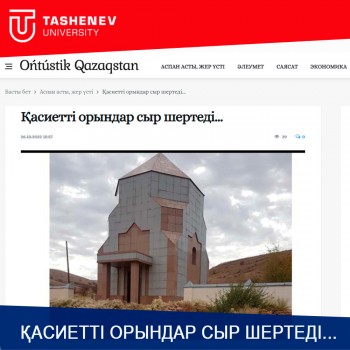Holy places are secret...
- 67 views
Сілтеме: https://okg.kz/post?id=30490&slug=qasietti-oryndar-syr-shertedi
Recently, on the initiative of doctor of pedagogy, professor Onalbai Ayashev, historians, philologists, together with media representatives visited the mausoleums of Mother Domalak, Baidibek Baba, Akmeshit Cave and Appak Ishan Mosque-Madrasah. The purpose of this visit is to get acquainted with the condition of historical places, to guide the research works and future scientific projects of the students of the Faculty of History, Archeology, and Philology from a thematic point of view, and to consider the places that will be the basis for their production practices.
The journey started from the mausoleum of mother Domalak and grandfather Baidibek. Baidibek Baba is the ancestor of the Saryuysin, Ysty, Shapyrashti, Oshakti, Alban, Suan, and Dulat clans. Four kilometers east of Baidibek baba's mausoleum, the mausoleums "Kos ana" and "Holy Five Mothers" were built for the second wife of the poet Zerip and her daughter-in-law Sylany (mothers Marau, Zerip and her daughters-in-law Zhupar, Sylany, Karashash). . Here, as a source of antiquity, the walls of the old mosque-madrasah, built of clay bricks, have been preserved in their original state.
After Baba mausoleum, pilgrims went to Akmeshit cave, the largest in Central Asia. It is not known when and how the cave, which covers an area of more than one hectare, was formed. Surprisingly, mulberry and elm trees are growing inside. The internal structure is similar to the form of a yurt. The air of the cave has the effect of lowering the upper blood pressure of the body, and a person walking in the cave for 20-30 minutes gets rid of bad energy.
At the end of the trip, the passengers stopped at the Appak Ishan mosque-madrasah, a historical relic located in Shayan settlement.
There was a lot of literature in Arabic and Persian languages in the library of the mosque-madrasa built by Kosym Ishan's grandson Appak Ishan. In 1927, Appak Ishan was also persecuted, and some parts of the mosque were deliberately destroyed.
This mosque-madrasah was turned into a museum thanks to the great work of our uncle Ozbekali Zhanibekov, an art critic and figure. There are wonderful historical relics and excellent exhibits. Apak Ishan's consumed items: a cape, a hand-woven carpet-jeynamazy, into which the whole world was put by his grandmother, manuscripts, old chagatai, books in Arabic languages, handicrafts: the gallery of hand-woven carpets is a secret from ancient times.
Ancient historical sites still need scientific research.
Lazzat ABENOVA,
Secretary of the University named after J. Tashenev.


Add new comment